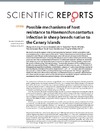Identificador persistente para citar o vincular este elemento:
https://accedacris.ulpgc.es/handle/10553/20867
| Campo DC | Valor | idioma |
|---|---|---|
| dc.contributor.author | Guo, Zhengyu | en_US |
| dc.contributor.author | González, Jorge Francisco | en_US |
| dc.contributor.author | Hernández Vega, Julia Natividad | en_US |
| dc.contributor.author | McNeilly, Tom N. | en_US |
| dc.contributor.author | Corripio-Miyar, Yolanda | en_US |
| dc.contributor.author | Frew, David | en_US |
| dc.contributor.author | Morrison, Tyler | en_US |
| dc.contributor.author | Yu, Peng | en_US |
| dc.contributor.author | Li, Robert W. | en_US |
| dc.date.accessioned | 2017-03-09T03:30:26Z | - |
| dc.date.accessioned | 2018-03-16T09:14:04Z | - |
| dc.date.available | 2017-03-09T03:30:26Z | - |
| dc.date.available | 2018-03-16T09:14:04Z | - |
| dc.date.issued | 2016 | en_US |
| dc.identifier.issn | 2045-2322 | en_US |
| dc.identifier.uri | https://accedacris.ulpgc.es/handle/10553/20867 | - |
| dc.description.abstract | Haemonchus contortus appears to be the most economically important helminth parasite for small ruminant production in many regions of the world. The two sheep breeds native to the Canary Islands display distinctly different resistant phenotypes under both natural and experimental infections. Canaria Hair Breed (CHB) tends to have significantly lower worm burden and delayed and reduced egg production than the susceptible Canaria Sheep (CS). To understand molecular mechanisms underlying host resistance, we compared the abomasal mucosal transcriptome of the two breeds in response to Haemonchus infection using RNAseq technology. A broad range of mechanisms have evolved in resistant CHB to provide protection against the parasite. Our findings suggest that readily inducible acute inflammatory responses, complement activation, accelerated cell proliferation and subsequent tissue repair, and immunity directed against parasite fecundity all contributed to the development of host resistance to parasitic infection in the resistant breed. | en_US |
| dc.format | application/pdf | - |
| dc.language | eng | en_US |
| dc.relation.ispartof | Scientific Reports | en_US |
| dc.rights | by-nc-nd | - |
| dc.source | Scientific Reports [ISSN 2045-2322], v. 6 (26200) | en_US |
| dc.subject | 310902 Genética | en_US |
| dc.subject | 240108 Genética animal | en_US |
| dc.subject.other | Quantitative Trait Loci | |
| dc.subject.other | Gastrointestinal Nematodes | |
| dc.subject.other | Parasite Resistance | |
| dc.subject.other | Dorper Sheep | |
| dc.subject.other | Red Maasai | |
| dc.subject.other | Amphiregulin | |
| dc.subject.other | Identification | |
| dc.subject.other | Inflammation | |
| dc.subject.other | Helminth | |
| dc.subject.other | Immunity | |
| dc.title | Possible mechanisms of host resistance to Haemonchus contortusinfection in sheep breeds native to the Canary Islands | en_US |
| dc.type | info:eu-repo/semantics/Article | en_US |
| dc.type | Article | en_US |
| dc.identifier.doi | 10.1038/srep26200 | |
| dc.identifier.scopus | 84970015771 | - |
| dc.identifier.isi | 000376554900001 | - |
| dc.contributor.authorscopusid | 56949480800 | - |
| dc.contributor.authorscopusid | 7404492965 | - |
| dc.contributor.authorscopusid | 57188977277 | - |
| dc.contributor.authorscopusid | 36978592100 | - |
| dc.contributor.authorscopusid | 14624902300 | - |
| dc.contributor.authorscopusid | 6603829629 | - |
| dc.contributor.authorscopusid | 57189390183 | - |
| dc.contributor.authorscopusid | 56849768100 | - |
| dc.contributor.authorscopusid | 8591086500 | - |
| dc.relation.volume | 6 | - |
| dc.investigacion | Ciencias | en_US |
| dc.project.reference | AGL2009/09985 | - |
| dc.rights.accessrights | Acceso libre | - |
| dc.type2 | Artículo | en_US |
| dc.contributor.daisngid | 3135694 | |
| dc.contributor.daisngid | 1988579 | |
| dc.contributor.daisngid | 5685596 | |
| dc.contributor.daisngid | 170985 | |
| dc.contributor.daisngid | 2251711 | |
| dc.contributor.daisngid | 285998 | |
| dc.contributor.daisngid | 9667861 | |
| dc.contributor.daisngid | 2510611 | |
| dc.contributor.daisngid | 458707 | |
| dc.contributor.wosstandard | WOS:Guo, ZY | |
| dc.contributor.wosstandard | WOS:Gonzalez, JF | |
| dc.contributor.wosstandard | WOS:Hernandez, JN | |
| dc.contributor.wosstandard | WOS:McNeilly, TN | |
| dc.contributor.wosstandard | WOS:Corripio-Miyar, Y | |
| dc.contributor.wosstandard | WOS:Frew, D | |
| dc.contributor.wosstandard | WOS:Morrison, T | |
| dc.contributor.wosstandard | WOS:Yu, P | |
| dc.contributor.wosstandard | WOS:Li, RW | |
| dc.date.coverdate | Mayo 2016 | |
| dc.identifier.ulpgc | Sí | es |
| dc.description.sjr | 1,625 | |
| dc.description.jcr | 4,259 | |
| dc.description.sjrq | Q1 | |
| dc.description.jcrq | Q1 | |
| dc.description.scie | SCIE | |
| item.grantfulltext | open | - |
| item.fulltext | Con texto completo | - |
| crisitem.author.dept | GIR IUSA-ONEHEALTH 4. Producción y Biotecnología Animal | - |
| crisitem.author.dept | IU de Sanidad Animal y Seguridad Alimentaria | - |
| crisitem.author.dept | Departamento de Patología Animal, Producción Animal, Bromatología y Tecnología de Los Alimentos | - |
| crisitem.author.dept | GIR IUSA-ONEHEALTH 4. Producción y Biotecnología Animal | - |
| crisitem.author.dept | IU de Sanidad Animal y Seguridad Alimentaria | - |
| crisitem.author.dept | Departamento de Patología Animal, Producción Animal, Bromatología y Tecnología de Los Alimentos | - |
| crisitem.author.orcid | 0000-0001-7374-9256 | - |
| crisitem.author.orcid | 0000-0002-3843-2509 | - |
| crisitem.author.parentorg | IU de Sanidad Animal y Seguridad Alimentaria | - |
| crisitem.author.parentorg | IU de Sanidad Animal y Seguridad Alimentaria | - |
| crisitem.author.fullName | González Pérez, Jorge Francisco | - |
| crisitem.author.fullName | Hernández Vega, Julia Natividad | - |
| Colección: | Artículos | |
Citas SCOPUSTM
69
actualizado el 01-jun-2025
Citas de WEB OF SCIENCETM
Citations
65
actualizado el 01-jun-2025
Visitas
72
actualizado el 30-dic-2023
Descargas
118
actualizado el 30-dic-2023
Google ScholarTM
Verifica
Altmetric
Comparte
Exporta metadatos
Los elementos en ULPGC accedaCRIS están protegidos por derechos de autor con todos los derechos reservados, a menos que se indique lo contrario.
